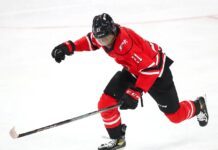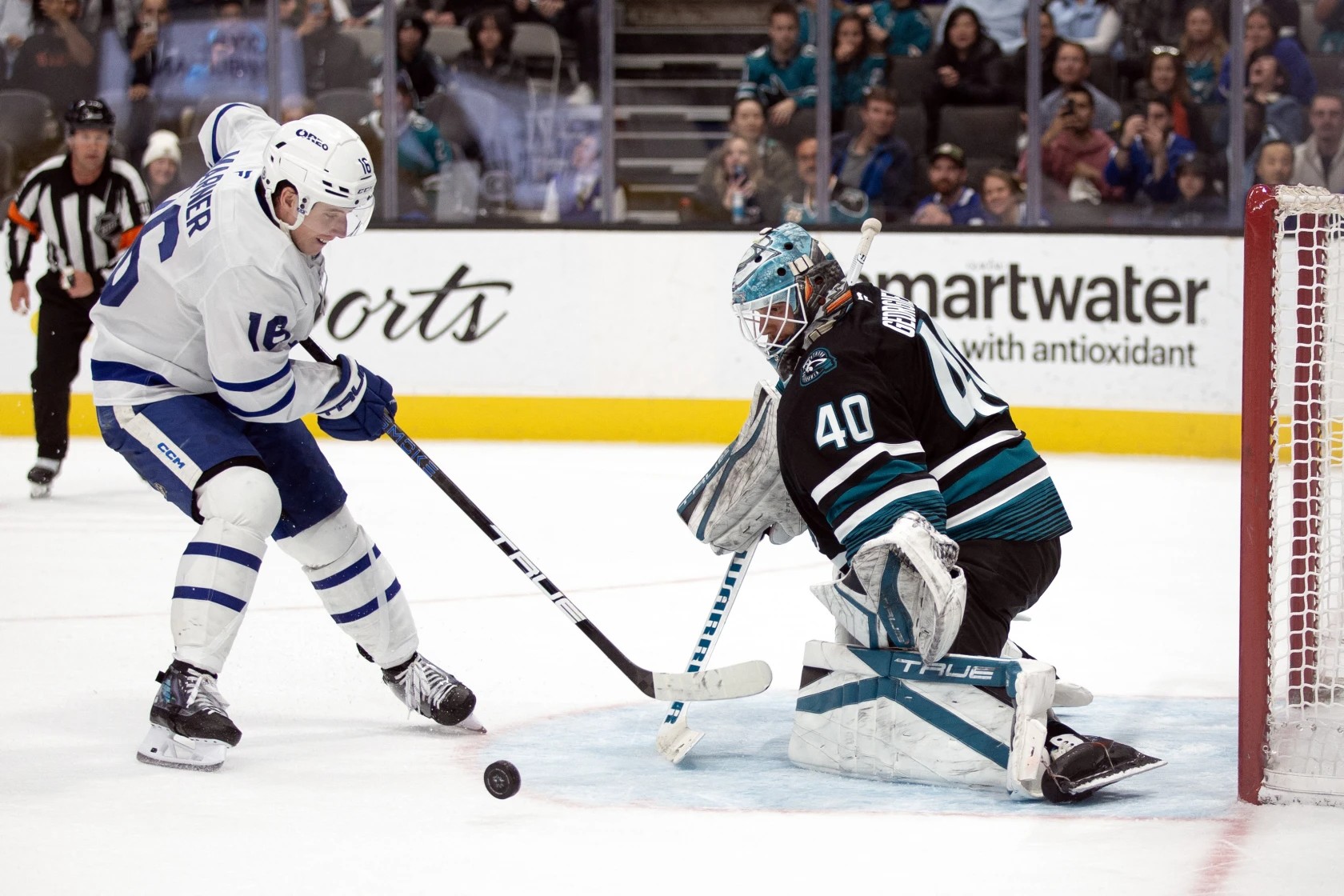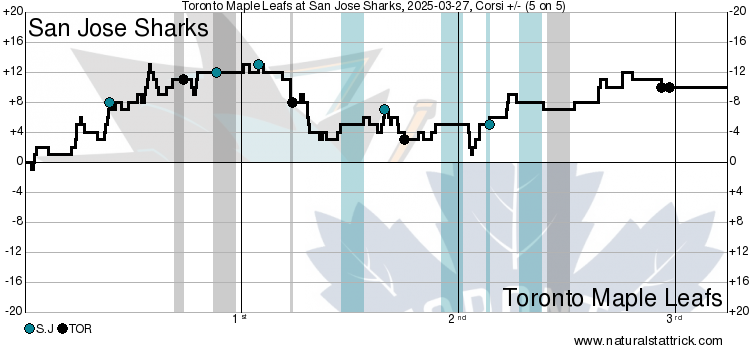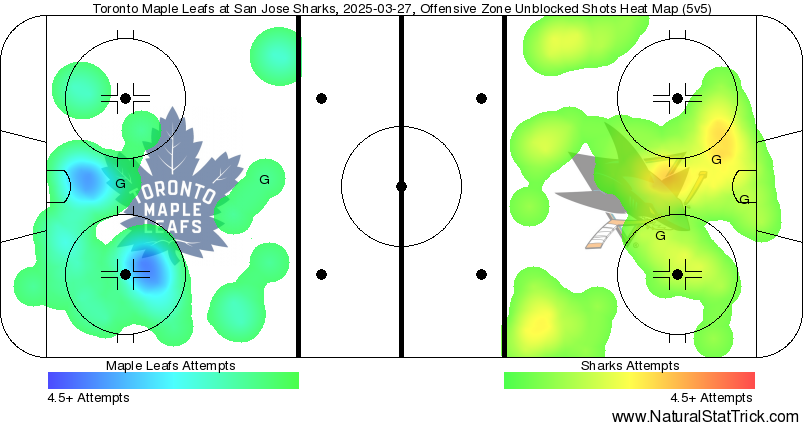For the second time in March, the Toronto Maple Leafs lost a shootout decision to the last-place San Jose Sharks, leaving an important point on the table in the Atlantic Division race.
This game’s script was pretty different from the last shootout loss to San Jose. It was a high-scoring affair, and this time, the Maple Leafs needed the third-period comeback to send it to overtime. Few Leafs fans will be happy with the overall performance, although a furious final-minute comeback at 6-on-5 at least salvaged a point for Toronto.
There’s much to break down from tonight’s ugly but entertaining affair:
1. If anyone on the Leafs thought this would be easy, the first eight minutes of this game should have sent a pretty clear wake-up message. The Sharks had the energy advantage right out of the gate; William Eklund set up Macklin Celebrini in the slot for a shot, and former Leaf, Timothy Liljegren, set up Tyler Toffoli for a good look. Five minutes into the game, the shots were 4-0 in favour of San Jose.
There were a few bright spots, including two positive shifts for Scott Laughton and his third line, but the balance of play favoured San Jose when the teams’ top two lines were facing off.
Eventually, San Jose drew first blood, stringing together an authoritative shift that saw them shoot and retrieve several times to keep possession. Bobby McMann‘s failed clear aided the Sharks’ cause, as San Jose worked over tired Leaf legs and broke down the Toronto DZ coverage.
Alex Wennberg passed to the slot to Collin Graf, who went to the point and found Liljegren, who found an activating Lucas Carlsson, creating a 2v1 down low. Oliver Ekman-Larsson blocked Carlsson’s initial centering attempt, but his second attempt made it to the crease and kicked right out to Toffoli, who finished it off.
After Simon Benoit finished his check on the wall, he was really slow getting back to the net front, and John Tavares didn’t come close to establishing inside positioning on Toffoli before it was in the back of the net. The Leafs were visibly defending tired at this point around 50 seconds into their shift.
The whole sequence and goal exemplified the early-stage gap in hunger and energy between the two teams.
2. The Leafs‘ situation initially didn’t improve much after the 1-0 deficit. An ugly defensive-zone turnover from Benoit led to a strong shift by the Alex Wennberg-led second line for San Jose, who continued to outskate and outwork a Leafs team caught in the mud.
The Leafs finally found their footing in the game off a strong shift from their second line, spending a good 45 seconds in the offensive zone. In the Leafs’ defensive zone, Ty Dellandrea hacked down Jake McCabe, giving Toronto’s red-hot power play a chance to draw even.
They executed thanks, in large part, to a savvy stick lift by Matthew Knies on defenseman Vincent Desharnais in front of the San Jose net. Desharnais thought he had time for a routine clearance, but Knies lifted his stick and swiped it from behind. Knies turned around and tossed it on net, and the puck kicked out to Nylander for a rebound goal. A good deal of credit for the Leafs’ five-forward success on the PP is owed to Knies’ grunt work in front of the net, and this was another good example.
Last year, Nylander scored his 40th goal at around the same point in the season, but then he went ice-cold to finish the campaign and ended up at an even 40 for the second straight season. This time, Nylander scored his 40th on Tuesday and didn’t wait a single game before setting a new career high at 41 with this game-tying goal. And it wouldn’t be his last tonight.
3. Back on even footing, the Leafs were given another opportunity to keep their PP rolling a couple of minutes later when Lucas Carlsson was called for interference. This PP did not go nearly as well for the Maple Leafs, as good sticks from Collin Graf and Mario Ferraro blocked a Nylander attempted seam pass, and a shorthanded rush headed the other way.
It was more or less a 3v2 situation in Toronto’s favour that the Leafs should’ve handled without much issue, even without a defenseman on the ice. Marner was back, and Nylander hustled to stay inside Goodrow and tie him up. Matthews stopped moving his feet and reached in to unsuccessfully take a swipe at the puck from behind on Graf, instead of skating back hard and taking the inside ice away. Goodrow and Nylander bumped into Marner at the same time, creating a bit of an opening across the slot as Graf cut away from Matthews to his right.
This sequence turned into a Graf shot between the hashmarks, which shouldn’t have happened. Any combination of Matthews finishing his back-check better, Marner seeing the green light to step up on Graf and potentially kill the play a bit earlier, or the awkward collision not happening, and this is a nothingburger shorthanded rush. From there, Graf fired back against the grain, fooling Joseph Woll with a stoppable shot.
4. At the first intermission, the Leafs had been outshot 15-8 at five-on-five in the first period, with scoring chances sitting at 11-4 San Jose and high-danger chances at 5-0 Sharks, per Natural Stat Trick. SJ fired 16 shots on goal in total in a period in which they did not have a single power play.
There didn’t seem to be much of a change in the Leafs’ fortunes after an 18-minute break to talk it over. The Sharks came right out and got a quick look for Tyler Toffoli in the opening minute, and then they struck again.
Benoit continued to struggle in the game, as he fairly pinched down to keep the puck in but totally whiffed on the puck, allowing San Jose to break on a 2v1 for Toffoli and Wennberg. With OEL selling out for the pass and leaving the shooter to his goalie, Wennberg trickled a puck through Woll. Woll has to come up with at least one of the two saves on the 2-1 or 3-1 tallies, but it was also a high-danger chance created by another error from Benoit, whose game has been riddled with them recently (frankly, most of his season has been riddled with them).
Philippe Myers doesn’t seem to have the same level of trust from the coaching staff, including on the PK — he hasn’t played since March 10 despite Benoit’s mixed performances — but at some point, it feels like they have to try something else for at least a couple of games. Myers has been quite imperfect in his own right, but it’s a new look/reset for Benoit and has the knock-on effect of shifting OEL back to the left, aligning the Leafs with three lefties and three righties on the blue line.
5. What breathed life back into the Leafs in the first period worked again in the second when Lucas Carlsson took his second penalty of the night just three minutes after the Wennberg goal. The Leafs’ white-hot power play took advantage in the blink of an eye.
They won the opening faceoff of the power play back and got it to Marner at the point, where his point shot squibbed through Alexandar Georgiev and was tapped into the empty net by Matthews, who crept down the backside of the play before Goodrow noticed him.
One asset of the Leafs’ five-forward setup has been Marner’s dynamic movement up top when walking the line and his ability to sift pucks into productive areas from the point. We saw a better example later in the game in another man-advantage situation at 6-on-5 — this 3-2 goal should’ve been a simple save and freeze for Georgiev, frankly — but Marner looks really confident with the puck up top in general and is making a lot of good things happen from up there.
6. The next nine or so minutes was the best stretch of hockey for San Jose’s young kids. Sharks head coach Ryan Warsofsky assembled three first-round picks on the top line — Macklin Celebrini centering Will Smith and William Eklund — and they generated multiple strong shifts during this segment. Celebrini made a wicked pass on one shift, and in his next time out, his line took it to the John Tavares-led second line, forcing a Nylander icing. Celebrini then skillfully drew a tripping penalty off McMann.
The Leafs got the kill, and Marner and Matthews went on a decent short-handed rush to create a look. The Sharks’ best chance came with their second unit as Liljegren set up fellow defenseman Shakir Mukhamadullin in the circle, but Woll made the save.
Back at five-on-five, the next chance for either team was another one from the San Jose youngsters, as Celebrini set up the trailer Smith to uncork a rocket that Woll stopped. The best line on the ice in the second period was the Celebrini line, which is great news for San Jose’s future but also bad news for the Maple Leafs’ top six tonight, particularly the top line, which was doing very little at evens.
San Jose’s kid line did eventually score 13 minutes into the period, although it’s not a goal they particularly earned. Woll made a disastrous puck-handling blunder when the puck rolled in on net; he seemed to wait a beat for Chris Tanev to spring open but sent his pass right into the closing-down Eklund at point-blank range. It went off Eklund’s skates and into the net in the biggest goaltending screw-up of the Leafs’ season.
7. Again, though, the Sharks’ two-goal lead only lasted a few minutes. The Toronto fourth line generated a very strong response shift. Steven Lorentz made a power move to the net, and the Leafs sustained enough offensive-zone pressure from there to bring in a partial change of fresh legs. That — plus a bizarre decision by Vincent Desharnais to eat a puck on the end boards instead of taking his out up the wall — was how we got a David Kämpf assist on a Scott Laughton goal.
Kampf and Laughton worked to dispossess Desharnais down low before Kampf teed Laughton up at the point as the Leafs worked it low-to-high. Laughton didn’t get 100% of his shot, but it glanced the top of Georgiev’s pad and found the net — a low-percentage shot led to a much-needed bounce Laughton’s way for his first as a Leaf in a solid game from the new Leaf.
The bottom six had a reasonable night overall, with the caveat that San Jose may have the worst bottom six in the entire league (i.e., the Leafs should win those minutes). Further up the lineup, now at 4-3, Matthews committed an ugly turnover high in the offensive zone, sending Will Smith on a partial breakaway, where he ripped it off the bar.
8. The second period ended with the Leafs on the PK after Max Domi got in a tussle with Zack Ostapchuk in the corner. Ostapchuk cross-checked Domi, and Domi responded by cross-checking back and attempting to drop the gloves, which Ostapchuk refused to oblige. Ostapchuk took two for the cross-check, while Domi received four for roughing plus a 10-minute misconduct that removed him from much of the third period.
The Domi absence caused some juggling with the lines in the third period, which began with the Leafs on a carryover PK. They killed it off but went right back to the PK after Nick Robertson got sloppy with his stick in the neutral zone, chopping the legs out from under Will Smith (it was a bit of a dive, to be fair), as the penalties keep piling up for #89 of late.
A bad breakdown undid an otherwise decent night on the PK. One simple pass down low created a 3v1 situation: Woll had to respect the shooter, Tanev had to take away the pass out front, and Toffoli was, therefore, wide open at the backside.
Seeing such confusion within the Leafs’ PK coverage/structure is a bit concerning so late in the regular season. When the puck found Celebrini on the right wall, rather than wait for Marner to come across, whether Matthews should’ve swapped into the +1 role and pressured the puck carrier instead of holding in the middle, and why McCabe stepped up and stood right next to Matthews vs. trusting his forwards to do their jobs, are questions for the coaches and players involved to sort out in the video room. This goal was too easy, and it smacks of a PK unit that is not on the same page often enough, given the time of season.
Before the Leafs’ 6-on-5 push, Natural Stat Trick credited the Leafs with only nine five-on-five shot attempts, five shots on goal, and .56 expected goals.
9. The Leafs haven’t been a prolific 6-on-5 team by any stretch this season, and this two-goal comeback seemed pretty unlikely when they struggled to get the goalie pulled and set up in the zone properly. In the second-to-last minute of the game, most of the action involved San Jose’s attempts to score into the empty net, including one try off the post from Toffoli and a save by Marner in the crease before the puck rolled in.
After those close calls, Tavares won an offensive-zone draw, and Marner continued to do a good job of moving his feet and finding a shooting lane from up top. Tavares continued to be lethal in the slot, tipping home his 33rd of the season and 11th in his last 13 games.
Tavares won another draw on the ensuing center-ice faceoff, and the Leafs quickly re-entered the offensive zone. They cycled around the perimeter for a chunk of time before Marner broke down San Jose’s DZ coverage and zipped a pass cross-seam to Matthews at the backdoor. Matthews looked sure to tie it, but Georgiev got across for a great save. Matthews followed up his chance, recovered the rebound, and returned it to Marner, who then calmly picked out Nylander for a nice finish.
Marner stepped up big for the Leafs late in this game at a time when they appeared dead in the water without much gas in the tank for a late surge.
10. The chaos continued in OT. Domi, finally released from the box late in the third period, went on a 2v1 with McMann; McMann kept it and shot it, but Georgiev made the save. Other looks for the Leafs included a Nylander solo rush, a Matthews shot that drilled the iron (and fooled Chris Cuthbert into thinking it was in), and a final shift from Matthews and Marner that nearly ended it twice.
Toronto had the better of the OT session, which has generally been a strength of theirs this season. Natural Stat Trick recorded the shot attempts at 11-4 in Toronto’s favour in OT (high-danger chances were 3-0).
The shootout started well for the Leafs — Nylander went in with speed and easily solved Georgiev — but Woll allowed back-to-back goals to Smith and Celebrini. Both were nice dekes, but it was not a strong game from Woll, who needed to come up with a few more saves somewhere along the way. At the other end of the ice, both Matthews and Marner were stopped by Georgiev, leaving the Leafs with one point that was as much or more than they earned.
After a strong game against a miserable Philadelphia team on Tuesday, the Leafs did not play a game to be proud of tonight. The start was particularly disappointing, given the importance of the points and the fact that the Leafs lost to this Sharks team just a few weeks ago. Before the game, Craig Berube pointed out that the Sharks still have their “juice”; it was visible tonight that there can still be a real spirit to their play, driven by their highly skilled youth, but the Leafs did not match their energy early.
The Leafs’ power play looked sharp again (SHG excepted), but their five-on-five play was nowhere near good enough, and the one PK breakdown was egregious. In particular, Toronto’s top line was outplayed by a line led by 18-year-old Celebrini for the second time in March, and Berube never seemed interested in switching it up. In net, Woll played one of his worst games of the season.
The result is that the Leafs have placed the ball back in Florida’s court by only taking one point from the 32nd-ranked team. The Panthers play tomorrow night at home against a Utah team that will be on the second night of a back-to-back, so it is fairly likely that the Leafs will be back in second place when they play again on Saturday night in LA. Saturday’s matchup comes against a Kings team that is nearly unbeatable at home and is 8-2-0 in their last 10. Toronto will need to be much better than what they showed tonight to keep this California road trip on the rails.
Game Flow: 5v5 Shot Attempts
Heat Map: 5v5 Shot Attempts
Game Highlights w/ Joe Bowen & Jim Ralph







































